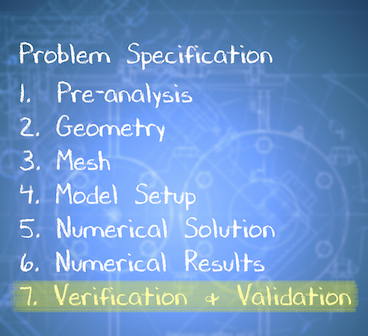| Include Page |
|---|
...
|
...
|
| Include Page |
|---|
...
|
...
|
Verification & Validation
Verification and validation can be thought as a formal process for checking results. We'll first check that the net heat flow to the domain is zero. Then we'll look into mesh refinement and comparison with the analytical solution.
In order to check that the net heat flow to the domain is zero, we need to export the heat flux variation at the bottom and right edges to MATLAB for numerical integration. We already exported qy for the bottom edge to qy_bot.txt. Similarly, export qx for the right edge to qx_right.txt.
We have written a MATLAB script that reads in these ANSYS data files and does the necessary numerical integration to calculate the total heat flux. Download the MATLAB script by right-clicking the link and saving to the directory containing qy_bot.txt: post.m. Running the file will graph the heat flux along each edge, as well as calculate the total heat flux through each of the two edges.
We will also look at the results for the dimensionless temperature along the line y=1. To change the mesh size, go back to Mesh > Edge Sizing in the tree and change the Number of Divisions appropriately. Click Solve. All results will be updated for the new mesh. The plot below contains information from 1x1, 2x2, 3x3, 5x5, and our 10x20 element mesh. Note how as the mesh gets finer (i.e. more elements,) the solution converges onto one line. This is a trivial example, as it converges by 5x5 elements, but consider how mesh refinement can affect results in a complex system.
In other words, Always do mesh refinements until the solution converges. If you don't, it is possible your simulation may be completely off from reality, and will be useless!
...
https://confluence.cornell.edu/download/attachments/146918522/Convergence.png
Verification Overview
| HTML |
|---|
<iframe width="640" height="360" src="https://www.youtube.com/embed/9RKcXN6xkD4" frameborder="0" allowfullscreen></iframe> |
Check Your Understanding
Select true or false.
Verification involves comparison with experimental data.
(To see the answer, go to the 2D Conduction section of Module 1 in
| New window link | ||
|---|---|---|
| ||
our free online course on ANSYS simulations. |
Check Energy Conservation
| HTML |
|---|
<iframe width="640" height="360" src="https://www.youtube.com/embed/DvWdFGyKvA4" frameborder="0" allowfullscreen></iframe> |
Check Numerical Error
| HTML |
|---|
<iframe width="640" height="360" src="https://www.youtube.com/embed/pyvOziL5mso" frameborder="0" allowfullscreen></iframe> |
Compare this to the analytic solution, and note how it converges on the same line:
This analytic solution has been derived, and is shown to be:
With the infinite series coefficient defined as:
And the Infinite eigenvalues are defined as:
Note that Theta, x, and y defined as dimensionless temperature, x coordinate, and y coordinate respectively. The X and Y were reduced by the width W.
 Sign-up for free online course on ANSYS simulations!
Sign-up for free online course on ANSYS simulations!
